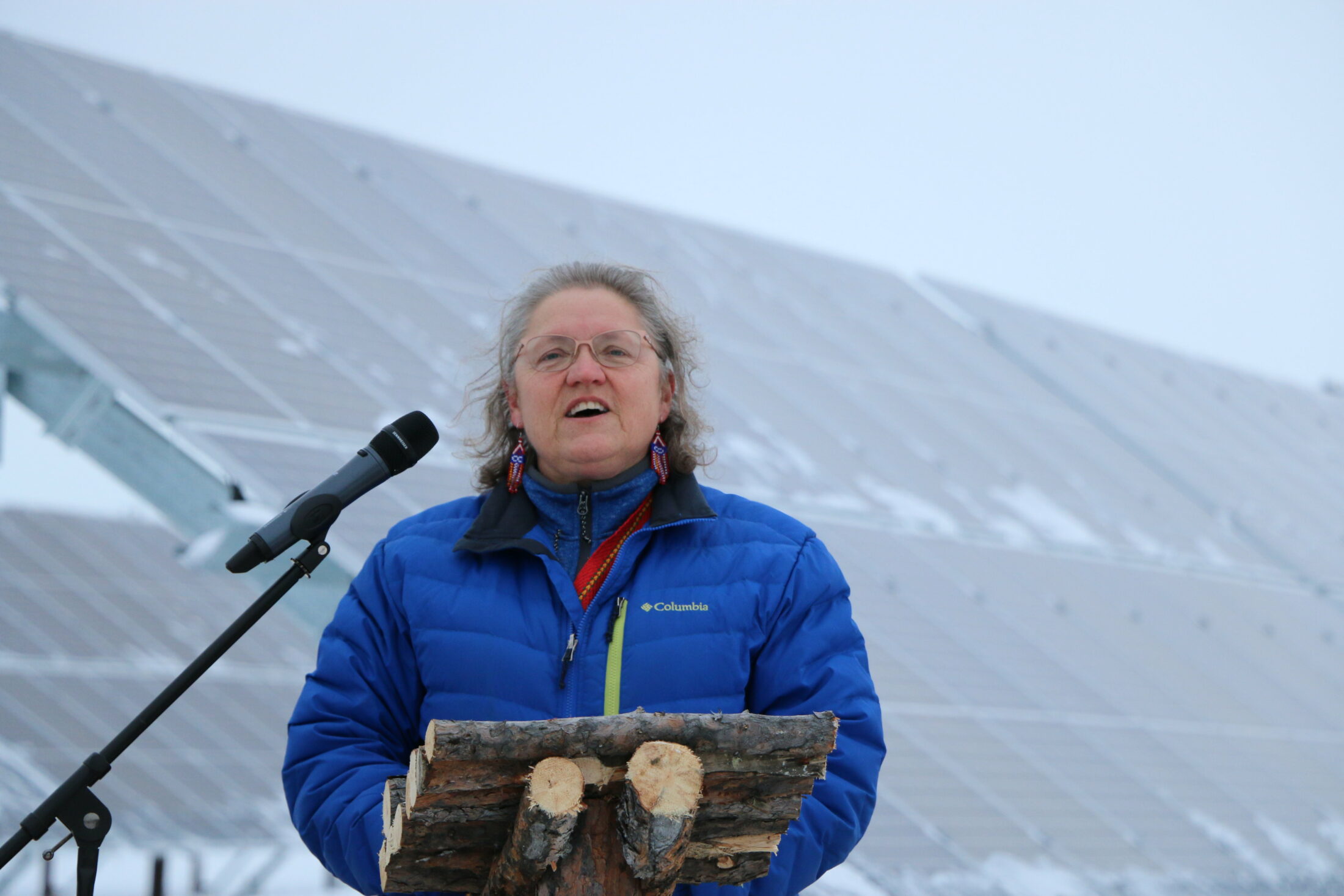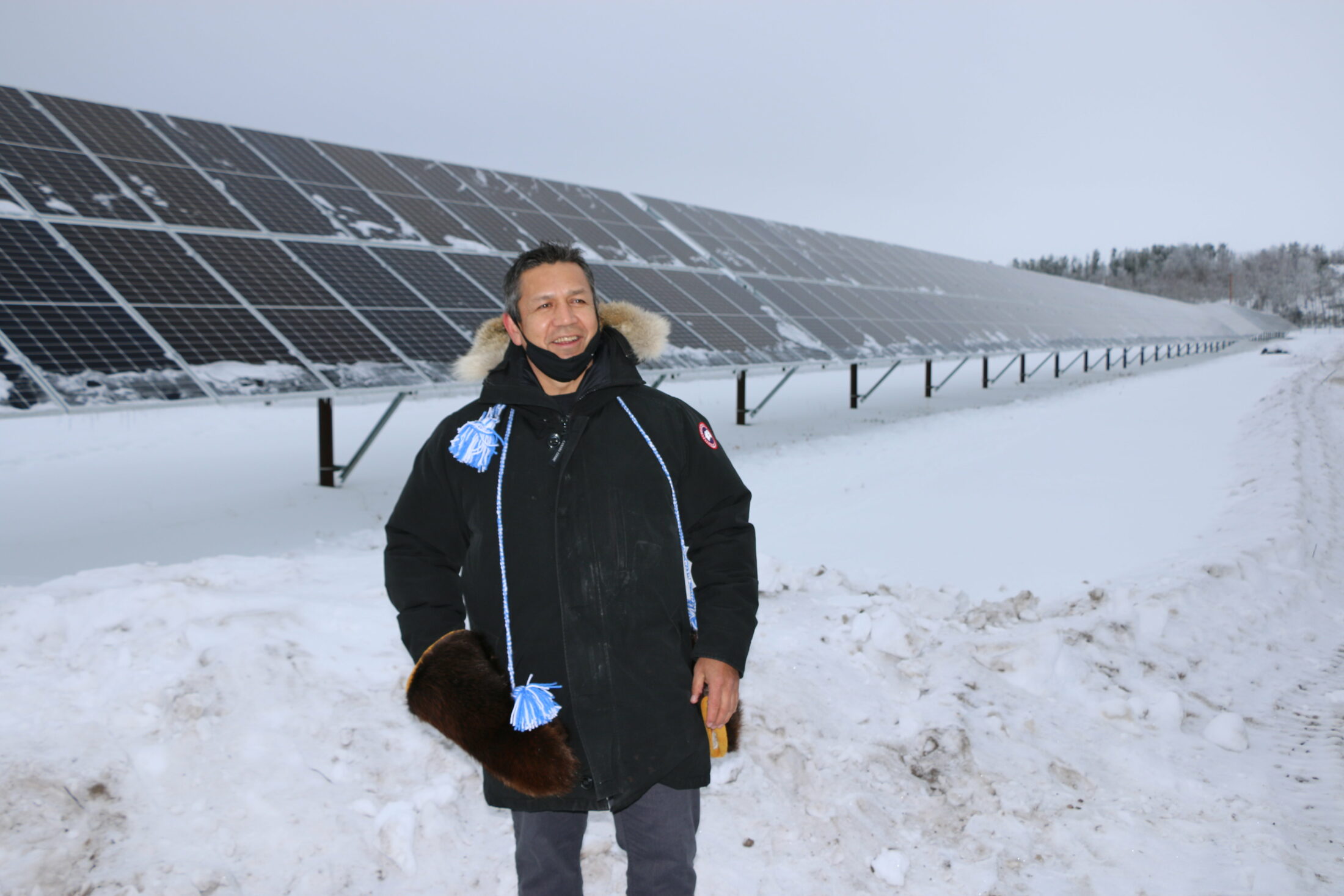The Indigenous-owned project will supply a quarter of Fort Chipewyan’s electricity needs, helping to reduce the need for almost a million litres of diesel each year
Ainslie Cruickshank Nov 18, 2020 THE NARWAL
A remote community less than 200 kilometres north of Alberta’s oilsands will soon get a quarter of its annual electricity from solar power.
Three Nations Energy (3NE), a corporation owned by Athabasca Chipewyan First Nation, Mikisew Cree First Nation and Fort Chipewyan Metis Association, announced the completion of their 2.2-megawatt solar farm in Fort Chipewyan this week.
Electricity from the $7.76 million 3NE solar farm, in combination with power from a nearby 600-kilowatt solar farm owned by ATCO and a battery storage system, will reduce the need for more than 800,000 litres of diesel fuel each year and cut greenhouse gas emissions by 2,250 tonnes — roughly the emissions from 486 cars over the course of a year.
Electricity from the solar projects, which together make up the largest remote solar farm in Canada, will begin flowing to the community grid in January.
“Our people have a proud tradition of making our livelihood from the sustainable use of local renewable resources,” Blue Eyes Simpson, vice president of Fort Chipewyan Metis Association and a 3NE director, said in a press release Wednesday.
“Reducing carbon emissions by replacing imported diesel with our locally owned solar farm uses new technology to act on these values in a way that will increase our energy security and self-sufficiency.” Simpson added.

Blue Eyes Simpson, vice president of Fort Chipewyan Metis Association, said the new solar farm will help reduce the community’s long reliance on diesel for electricity. The project will help reduce the community’s diesel consumption by nearly one million litres.
Photo: Nick Kendrick / Greenplanet Energy Analytics
Renewables and the oilsands: ‘we can do both’
Fort Chipewyan, a remote community located on the northwest shore of Lake Athabasca and just outside of Wood Buffalo National Park, can only be accessed by plane or boat during the summer or by winter road for just a few months each year.
The community of roughly 1,000 people is not connected to Alberta’s main power grid and has relied on diesel that’s trucked in during the winter and stored in tanks to provide electricity throughout the year.
“We are already seeing the impacts of climate change on the Peace Athabasca Delta,” Athabasca Chipewyan First Nation Chief Allan Adam said in the release. Research has long suggested the delta may be drying due to climate change.
But Adam doesn’t think the Nation needs to choose between the oilsands and renewables.
In a statement included in the press release, Adam said his nation may be dependent on the oilsands for jobs and investment revenue, but added “that doesn’t mean forcing us into a false choice between a strong fossil fuel industry and protecting climate and the environment.”
“We can do both,” he said.
“It all starts with what we do here at home, cleaning up our own emissions like this solar farm will do for electricity in Fort Chip,” Adam added.
Indigenous-led project a ‘model for Canada’s green energy future’
The project was hailed as another example of the importance of Indigenous involvement in the energy sector — both in fossil fuels and renewables.
Mikisew Cree First Nation Chief Peter Powder said in the release that the solar project helps build “the capacity of our own tradespeople, workers and contractors to participate in the emerging green energy sector — just as we now play a major role contributing to the success of the fossil fuel industry of Alberta.”
The importance of Indigenous involvement in resource projects was emphasized by Alberta’s Minister of Indigenous Relations Rick Wilson, who said in a video message: “Indigenous people must have an equity stake in resource projects if there’s going to be a healthy future for our vital resource industries and for communities to prosper.”
“Projects like this one will benefit generations to come,” he said.

Chief Peter Powder of the Mikisew Cree First Nation stands in front of the new solar farm. The project is located in Fort Chipewyan, just 200 kilometres north of Alberta’s oilsands.
Photo: Nick Kendrick / Greenplanet Energy Analytics
In his own video message, Natural Resources Canada Minister Seamus O’Regan commended the project as “a model for Canada’s green energy future — one that is Indigenous-led.”
“We welcome your determination in building the energy capacity to reduce the community’s reliance on diesel, to reduce pollution and to address a climate crisis that has taken a particularly heavy toll on your region,” he said.
In Canada’s north, communities have long relied on diesel for electricity. In Nunavut, for example, 55 million litres of diesel are burned each year to provide power to the territory’s 38,000 people.
Prime Minister Justin Trudeau pledged in his 2019 campaign platform to ensure Indigenous communities that rely on diesel are powered by renewable energy by 2030.
Renewable energy set to double in remote areas
According to a July 2020 report by the Pembina Institute, renewable energy projects in remote communities almost doubled between 2015 and 2020. However, there’s much more work to do to complete the transition to renewable energy in these areas.
The report notes population growth has increased annual diesel consumption in remote communities, alongside the gains in renewable energy.
Dave Lovekin, director of the Pembina Institute’s work on renewables in remote communities and co-author of the report, said “it’s a huge leap forward” to see a project the size of the Fort Chipewyan solar farm completed.
“It’s a testament to how quickly things are starting to happen,” he told The Narwhal.
“Comparatively when you look back over the past few decades, things are moving much more aggressively, bigger systems are being developed [and] lots of lessons are being learned.”
“All of that is really built on the leadership that’s being developed in First Nations and Indigenous communities across Canada,” he said.
Ainslie Cruickshank is a Vancouver-based journalist focused on stories about the environment. She has written for the the Toronto Star
Renewables and the oilsands: ‘we can do both’
Fort Chipewyan, a remote community located on the northwest shore of Lake Athabasca and just outside of Wood Buffalo National Park, can only be accessed by plane or boat during the summer or by winter road for just a few months each year.
The community of roughly 1,000 people is not connected to Alberta’s main power grid and has relied on diesel that’s trucked in during the winter and stored in tanks to provide electricity throughout the year.
“We are already seeing the impacts of climate change on the Peace Athabasca Delta,” Athabasca Chipewyan First Nation Chief Allan Adam said in the release. Research has long suggested the delta may be drying due to climate change.
But Adam doesn’t think the Nation needs to choose between the oilsands and renewables.
In a statement included in the press release, Adam said his nation may be dependent on the oilsands for jobs and investment revenue, but added “that doesn’t mean forcing us into a false choice between a strong fossil fuel industry and protecting climate and the environment.”
“We can do both,” he said.
“It all starts with what we do here at home, cleaning up our own emissions like this solar farm will do for electricity in Fort Chip,” Adam added.
Indigenous-led project a ‘model for Canada’s green energy future’
The project was hailed as another example of the importance of Indigenous involvement in the energy sector — both in fossil fuels and renewables.
Mikisew Cree First Nation Chief Peter Powder said in the release that the solar project helps build “the capacity of our own tradespeople, workers and contractors to participate in the emerging green energy sector — just as we now play a major role contributing to the success of the fossil fuel industry of Alberta.”
The importance of Indigenous involvement in resource projects was emphasized by Alberta’s Minister of Indigenous Relations Rick Wilson, who said in a video message: “Indigenous people must have an equity stake in resource projects if there’s going to be a healthy future for our vital resource industries and for communities to prosper.”
“Projects like this one will benefit generations to come,” he said.

Chief Peter Powder of the Mikisew Cree First Nation stands in front of the new solar farm. The project is located in Fort Chipewyan, just 200 kilometres north of Alberta’s oilsands.
Photo: Nick Kendrick / Greenplanet Energy Analytics
In his own video message, Natural Resources Canada Minister Seamus O’Regan commended the project as “a model for Canada’s green energy future — one that is Indigenous-led.”
“We welcome your determination in building the energy capacity to reduce the community’s reliance on diesel, to reduce pollution and to address a climate crisis that has taken a particularly heavy toll on your region,” he said.
In Canada’s north, communities have long relied on diesel for electricity. In Nunavut, for example, 55 million litres of diesel are burned each year to provide power to the territory’s 38,000 people.
Prime Minister Justin Trudeau pledged in his 2019 campaign platform to ensure Indigenous communities that rely on diesel are powered by renewable energy by 2030.
Renewable energy set to double in remote areas
According to a July 2020 report by the Pembina Institute, renewable energy projects in remote communities almost doubled between 2015 and 2020. However, there’s much more work to do to complete the transition to renewable energy in these areas.
The report notes population growth has increased annual diesel consumption in remote communities, alongside the gains in renewable energy.
Dave Lovekin, director of the Pembina Institute’s work on renewables in remote communities and co-author of the report, said “it’s a huge leap forward” to see a project the size of the Fort Chipewyan solar farm completed.
“It’s a testament to how quickly things are starting to happen,” he told The Narwhal.
“Comparatively when you look back over the past few decades, things are moving much more aggressively, bigger systems are being developed [and] lots of lessons are being learned.”
“All of that is really built on the leadership that’s being developed in First Nations and Indigenous communities across Canada,” he said.
Ainslie Cruickshank is a Vancouver-based journalist focused on stories about the environment. She has written for the the Toronto Star
No comments:
Post a Comment